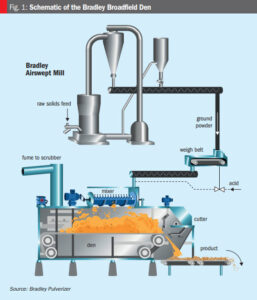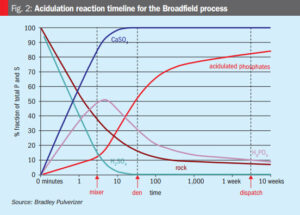Part 1 of a 5-part blog series: “Minimizing Heavy Metals in Superphosphate Manufacturing”
 The cadmium and heavy metal content of sedimentary phosphates are of great concern. This has seen industry raw material consumption shift towards igneous phosphates or the blending of phosphate rocks from different sources. While rock blending can successfully reduce the heavy metal content of superphosphates, it needs to be accompanied by careful process adjustments Click Here to download the complete article in pdf format as published by BCInsight Ltd in Fertilizer International Nov|Dec 2023, issue 517, pp. 53-57.
The cadmium and heavy metal content of sedimentary phosphates are of great concern. This has seen industry raw material consumption shift towards igneous phosphates or the blending of phosphate rocks from different sources. While rock blending can successfully reduce the heavy metal content of superphosphates, it needs to be accompanied by careful process adjustments Click Here to download the complete article in pdf format as published by BCInsight Ltd in Fertilizer International Nov|Dec 2023, issue 517, pp. 53-57.
Introduction
The manufacture of single superphosphate (SSP) and triple superphosphate (TSP) fertilizers, through acidulation of fluorapatite rock, continues to evolve. Process adaptations have been necessary, for example, in response to the consumption and depletion of known phosphate rock resources worldwide. In addition to the more obvious economic consequences, the environmental impacts of declining phosphate rock quality also demand attention and must be compensated for by the production process. Avoiding the presence of unacceptable levels of cadmium and other heavy metals in phosphate fertilizers is a particular concern and priority – as this can eventually lead to soil contamination.
Farmers first began applying phosphorus-rich materials to soils over 200 years ago by adding ground animal bones to provide crops with beneficial nutrients. The subsequent development of NPK fertilizers eventually paved the way for the large-scale fertilization of crops that is commonplace today. The development of the Broadfield® process by the Bradley Pulverizer Company in 1936 boosted the worldwide production of commercial fertilizers to new levels. This made the mass production of superphosphate fertilizers possible for the first time. The process produces single superphosphate (SSP) by acidulation of phosphate rock with sulphuric acid, while the addition of phosphoric acid produces triple superphosphate (TSP) and other enriched superphosphates.
Single superphosphate production
SSP production (see Fertilizer International 510, p61 for full process description) begins with the grinding of crushed phosphate rock (mainly fluorapatite, Ca3(PO4)2CaF2) in an airswept Bradley mill (Figure 1) to generate particles of the specified size (commonly 53–150µm). The resulting powder is then continuously fed into a Broadfield mixer along with sulphuric acid produced on-site. The mixer agitates the rock/acid mixture and, by coating the rock particles with the acid, kicks off the following chemical reaction: 2Ca5 (PO4)3F + 6H2SO4 + 3H2O → 6CaSO 4 + 3Ca(H2PO4)2 lH2O + CaF2
After an average reaction time of 3-4 minutes (Figure 2), the mixture is discharged as a cake into a rugged, sealed den (Figure 1). Exothermic reactions continue within the den for approximately 20-40 minutes as the material is slowly conveyed towards the exit. On leaving the Broadfield den, the material is extruded through a cutter to break the cake into granules. It is then stored for an average of 7-10 days to allow the complete conversion of insoluble phosphate rock into water-soluble SSP fertilizer.
The acidulation process is something of a balancing act. While the number of mechanical process variables is kept to a minimum, the few that are available are designed for production flexibility, regularly allowing machines to operate at between 60-110 percent of their rated capacity.
The sulphuric acid required by the process is often generated on-site and is relatively inexpensive in comparison to overall operating costs. This means that the economics of continuous superphosphate production, at consistent yields, is primarily determined by the quality/chemistry of the phosphate rock feed. In fact, it is fair to say that superphosphate production economics are totally dependent on the phosphate rock source.
The relatively long operating life of Broadfield equipment – and the need to accommodate increasingly frequent changes to the price, quality and specifications of raw materials – means superphosphate plants have to be installed with both foresight and flexibility. To minimize costs, new installations need to combine sensible process design and operational flexibility with the latest process controls and materials technology. Equipment upgrades generally remain an economic option even for long-lived plant operations. In fact, some Broadfield dens have continuously operated for more than 50 years. Over this period, they have experienced a marked decline in the average phosphate feedstock grade (P2O5), down from 36 percent originally to a level of 27 percent or less currently.
Continue to Part 2 – Environmental Consideration in Superphosphate Production
Contact us to learn more about how we can help you to solve any issues you may be having related to minimizing heavy metal concentrations in your fertilizer manufacturing process.


